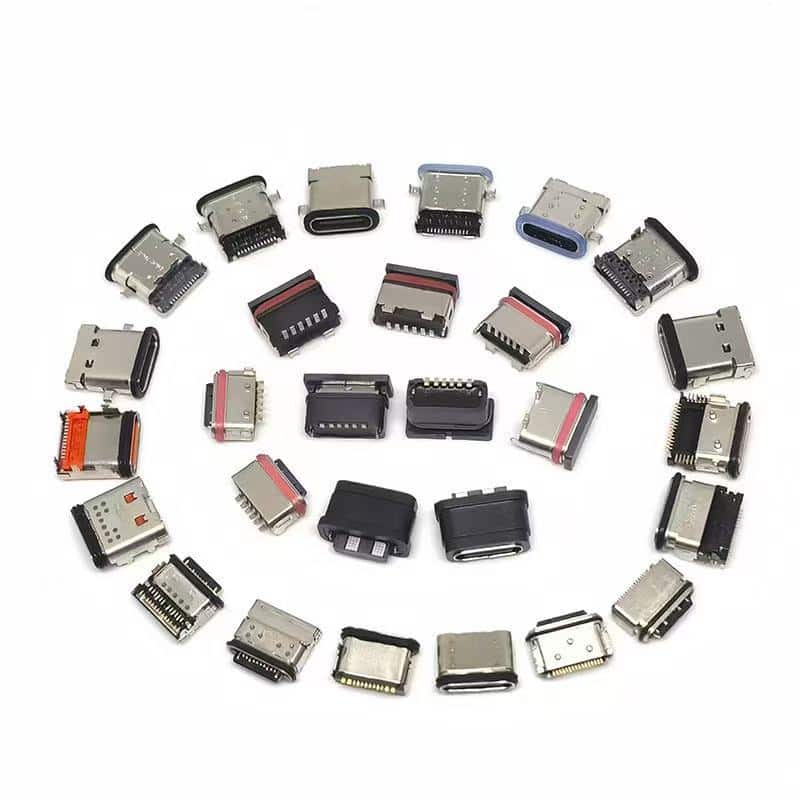USB type c Waterproof are commonly found in smartphones, action cameras, and other devices, and proper use can effectively extend their life and maintain waterproof performance. Here are the detailed notes:
I. Safety Protocols
- Avoid Direct Contact
◦ Prevent Injuries: To avoid cuts, do not touch the USB type c waterproof internal pins or chips when plugging or unplugging.
◦ Electrical Safety: Never touch the USB type c connector port while powered on to prevent short circuits or electric shocks. - Electrical Limits
◦ Rated Current: Do not exceed the specified current (e.g., 3A max devices should not use 5A chargers) to prevent overheating, accelerated aging, or fire hazards.
◦ Voltage Tolerance: Ensure the port’s withstand voltage is ≥AC500V. Verify compatibility in high-voltage environments (e.g., industrial equipment) to avoid burnout.

II. Proper Handling & Maintenance
- Plug/Unplug Correctly
◦ Gentle Alignment: Insert/remove connectors vertically to avoid damaging the sealing gasket.
◦ Power Off First: Disconnect devices before plugging/unplugging to reduce electrical surges. - Post-Use Care
◦ Disconnect Promptly: Remove cables after use to prevent prolonged current exposure that degrades transmission chips.
◦ Dust Protection: Always cover the port with the original dust cap when unused.
III. Environment & Compatibility
- Specification Matching
◦ No Mixing Standards: Use only compatible ports for specific devices (e.g., phones, cameras) to avoid physical or functional damage. - Corrosion Prevention
◦ Avoid Harsh Liquids: Rinse with fresh water and dry thoroughly after exposure to seawater, chlorine, or chemicals.
◦ Extreme Conditions: Avoid prolonged use in high humidity (>60°C) or steam to prevent internal condensation.
IV. Regular Maintenance
- Cleaning
◦ Debris Removal: Clean monthly with a dry soft brush; use 75% alcohol on cotton swabs for stubborn dirt. Never soak or use corrosive cleaners.
◦ Dry Thoroughly: Air-dry for 12+ hours if wet; avoid heat sources like hair dryers. - Seal Inspection
◦ Check Sealing Gaskets: Inspect every 3 months for cracks or loss of elasticity; replace with OEM parts if damaged.
◦ Waterproof Test: Conduct shallow immersion tests (e.g., 30cm water for 30 minutes for IP67) followed by full drying.
V. Professional Care
- No DIY Repairs: Tampering voids waterproofing; seek certified technicians for internal fixes.
- Annual Checkups: Test electrical and waterproof performance yearly for heavy-use devices.
- OEM Parts Only: Use manufacturer-approved replacements to ensure compatibility and safety.
VI. Emergency Response
- Water Exposure: Power off → dry port → air-dry 48 hours → confirm dryness before reuse.
- Overheating: Disconnect immediately if overheating occurs and seek professional repair.
VII. Device-Specific Recommendations
- Smartphones & Tablets
◦ Charging in Wet Conditions: Even with waterproof ratings, avoid charging immediately after exposure to moisture. Wait 2-3 hours for internal drying.
◦ Case Compatibility: Ensure phone cases don’t obstruct the port’s sealing gasket or trap debris. - Action Cameras & Drones
◦ Saltwater Exposure: Rinse ports with distilled water after ocean use to prevent salt crystal buildup.
◦ Field Repairs: Carry portable silicone seals for temporary fixes during outdoor adventures. - Industrial & Medical Devices
◦ High-Pressure Cleaning: IP69K-rated ports can withstand steam, but verify manufacturer guidelines for sterilization cycles.
◦ EMI Shielding: Use ferrite cores on cables in high-interference environments to protect data integrity.
VIII. Troubleshooting Common Issues
- Port Not Recognized
◦ Quick Fixes: Clean debris with a plastic pick, reboot the device, or try a different cable.
◦ Advanced Checks: Use a multimeter to test port voltage (should be 5V ±10%). - Slow Charging/Data Transfer
◦ Cable Inspection: Look for frayed wires or bent connectors; replace cables certified for USB-PD (Power Delivery).
◦ Software Conflicts: Update device firmware or reset USB preferences in system settings. - Intermittent Connectivity
◦ Seal Interference: Check if third-party accessories (e.g., magnetic adapters) misalign the port.
◦ Corrosion Signs: Green/white residue on pins indicates oxidation—gently scrub with isopropyl alcohol.
IX. Industry Standards & Certifications
- USB-IF Certification
◦ Importance: Look for the USB-IF logo to ensure compliance with power, data, and waterproofing standards.
◦ Testing: Certified ports undergo 10,000+ plug/unplug cycles and 72-hour humidity tests. - IP Rating Breakdown
◦ IP67 vs. IP68: IP67 protects against 1m submersion for 30 mins; IP68 offers deeper/longer protection (varies by brand).
◦ Beyond IP68: Military-grade MIL-STD-810G devices tolerate extreme temperatures, shocks, and dust.
X. Future-Proofing & Tech Trends
- USB4 & Thunderbolt 4
◦ Speed & Power: Up to 40Gbps data transfer and 100W charging—ensure cables and ports support these protocols.
◦ Waterproofing Challenges: Higher power demands require reinforced insulation and heat-resistant seals. - Self-Healing Materials
◦ Innovative Seals: Emerging polymers can repair minor cracks when exposed to heat (e.g., sunlight). - Wireless Alternatives
◦ Qi2 & MagSafe: Reduce port wear by using wireless charging where possible, especially in dusty/wet environments.
XI. User Case Studies
- Adventure Photographer
◦ Problem: Frequent sand exposure damaged a drone’s waterproof usb c connector during desert shoots.
◦ Solution: Weekly cleaning with compressed air and using a magnetic dust cap extended the port life by 200%. - Marine Research Team
◦ Problem: Saltwater corrosion caused data loss in underwater sensors.
◦ Solution: Switching to titanium-alloy ports and monthly freshwater rinses eliminated failures.
